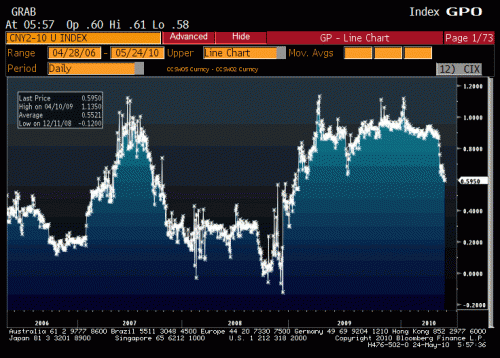Chinese Banks: Aggressive tightening could spell trouble for non-performing loans
As the Chinese government looks to slow the economy, non-performing loans in the banking sector will come into view. Clearly, the Chinese authorities want to slow the pace of house price and consumer price inflation and reduce rampant speculation in shares and property. However, getting too aggressive could create a lot of non-performing loans when the asset bubbles burst.
Andy Lees of UBS has a note out today about how the clampdown on loan growth could affect Chinese banks. Andy notes that Chinese banks are still looking to raise $27 billion and he believes their shares should be avoided. The yield curve in China is flattening very quickly. Andy says you can see this from the falloff in the swaps curve.
Notice how steeply the 2-10 year CNY swaps curve fell as the Chinese tightened in 2007, only to rise equally aggressively after Lehman collapsed when the Chinese authorities flooded the economy with money. As yet, we are no where near the levels of decline we saw in 2007. But the events bear remembering regarding non-performing loans. Andy writes:
In 2008 the central bank’s reserve ratio requirement of 17.5% had pushed loan growth to its lowest level in 2 years, putting the financial system under pressure. A report by the Chinese Banking Regulatory Reform Commission to the government warned that the number of Chinese banks whose liquidity ratio had dropped below the regulatory minimum of 25% had increased by 85 to 392 in the 5 months to July 2008. The so-called excess reserve ratio of bank deposits that lenders voluntarily lodge with the central bank in addition to the required reserves fell to the lowest level since records began in 2001, reflecting the strain on bank finances. As the government eased monetary policy and stimulated the economy, the bad loan ratio collapsed but that was to a large degree a function of the denominator. I think something similar is going to happen again very soon.
The financial distress is already evident in the public sector. Back in March, China Daily noted:
A township government in Shanghai reportedly borrowed 2 billion yuan ($293 million) in 2008 under the cover of a national high-speed railway project to repay debt, highlighting the risk of spiraling local government debts.
The Guangzhou-based 21st Century Business Herald reported the news on Wednesday, citing an audit document that was allegedly filed by the National Audit Office (NAO) in 2009 and recently obtained by the paper.
The case reveals the huge pressure placed on China’s regional governments to finance their spending as China boosts its economy with a 4-trillion-yuan stimulus plan.
As I have noted in the past, the low public sector debt levels in China are an illusion. Despite the fact that Chinese municipalities are forbidden from directly issuing bonds, there are 3,000 commercial financial institutions through which they have borrowed – and speculated on land prices – very heavily. Property bubbles are inherently related to land prices since the cost of building materials do not rise as quickly as property prices in a bubble. Municipalities know this and have been speculating in land purchases.
At the same time, real estate developers, local government officials and investors have escalated housing prices across the country by acquiring massive land holdings, limiting the supply and inflating prices, creating a real estate bubble that is not sustainable in the long run.
Read more: https://www.creditwritedowns.com/2009/10/huge-property-bubble-in-china.html#ixzz0oq8FGUXK
When this bubble pops, there will be lots of non-performing loans accruing in the financial sector. And unless the Chinese loosen liquidity again, as they did in late 2008, non-performing loans will be a big problem.
Source
High-speed railway loan misused – China Daily

Comments are closed.